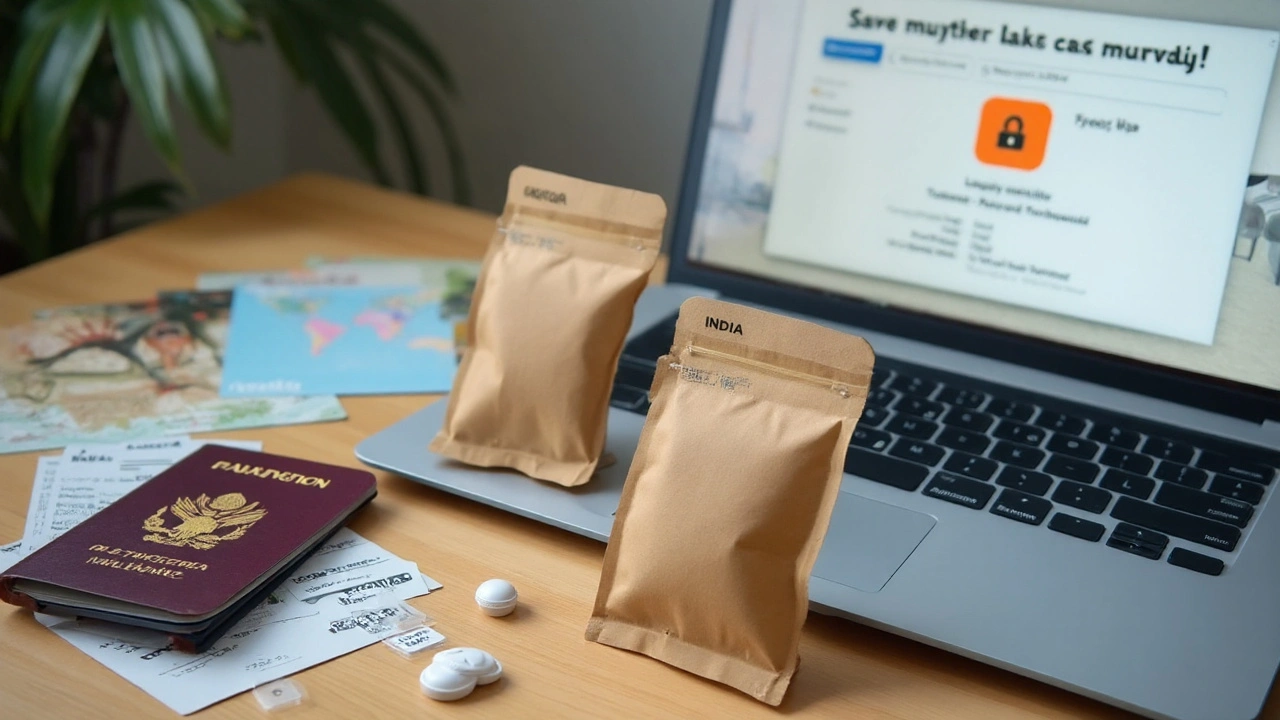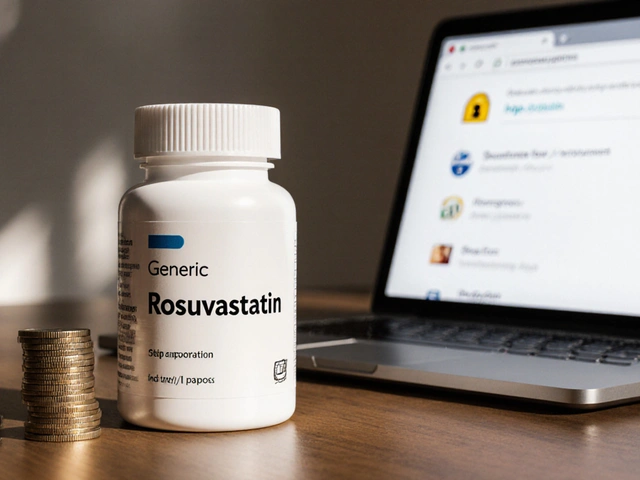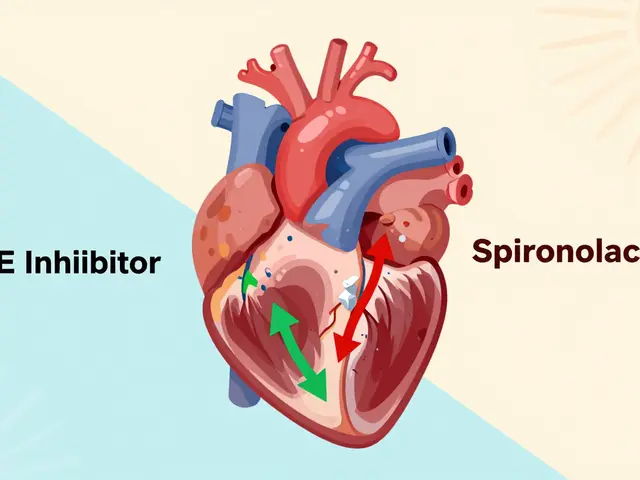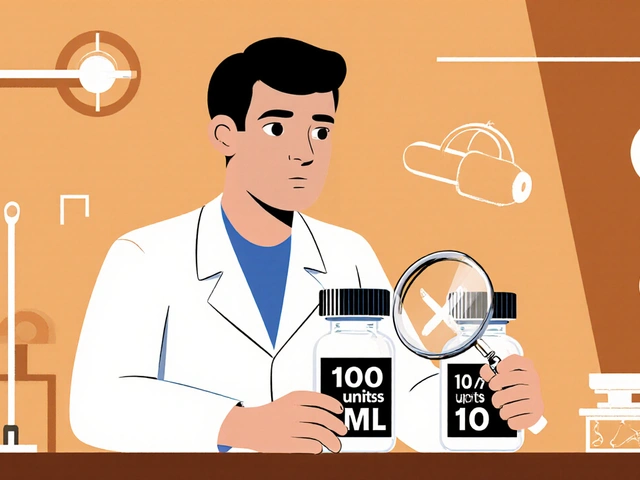If you searched “Venlor,” you probably want two things fast: what it actually is and how to get the right, safe version without getting burned. Here’s the short answer: Venlor is a branded venlafaxine (an SNRI antidepressant), most common in India and parts of Africa. In Canada (where I live, in Calgary), you’ll usually see venlafaxine XR sold as generic or as Effexor XR, not Venlor. Below, I’ll show you how to confirm the exact product, find the official monographs in under a minute, and make good choices on dose, safety, and buying-without drowning in jargon.
What Venlor Is, Who Makes It, and How It Compares
Venlor is a brand name for venlafaxine, an SNRI (serotonin-norepinephrine reuptake inhibitor) used for major depressive disorder (MDD), generalized anxiety disorder (GAD), social anxiety disorder (SAD), and panic disorder. It’s widely known under “Venlor XR” (Cipla) in India/South Africa. In Canada, the same medicine is available mostly as generic venlafaxine extended-release (XR) and as Effexor XR. The active ingredient is the same; release mechanisms and capsule beads may differ by brand/manufacturer.
Key takeaways if you’re trying to match names:
- Ingredient: venlafaxine (IR = immediate-release; XR/ER = extended-release).
- Brands: Venlor XR (Cipla) abroad; Effexor XR (Pfizer) and generics in Canada/US.
- Indications: MDD, GAD, SAD, panic disorder (check your country’s label; indications vary).
- Mechanism: Low doses mainly serotonin effect; above ~150 mg/day, norepinephrine effect becomes stronger; at higher doses, mild dopamine activity.
If you’re in Canada: pharmacies won’t stock “Venlor” by name. Ask for venlafaxine XR or Effexor XR. If your prescription says “Venlor XR” from an overseas doctor, your Canadian pharmacist will dispense an equivalent venlafaxine XR product.
Go-To Sources: Fast Path to the Official Monograph and Safe Pharmacies
Here’s the quickest way to land on trustworthy, official information and avoid sketchy pharmacies that sell look-alikes.
- To verify the exact Venlor XR product (Cipla insert):
- Search: “Cipla Venlor XR product insert PDF”.
- Open the result from Cipla’s official site. Confirm: strengths (often 37.5 mg, 75 mg, 150 mg), XR formulation, revision date, and country of approval.
- Check the section titles: indications, dosing, contraindications, adverse reactions, interactions.
- Canada (same drug, different brands):
- Search: “Effexor XR product monograph Health Canada PDF” or “venlafaxine XR product monograph Health Canada”.
- Open the Health Canada Drug Product Database monograph. Confirm dosage forms (usually 37.5/75/150 mg XR), approved uses, and safety warnings.
- United States labeling (if you need a second reference):
- Search: “venlafaxine extended-release label FDA”.
- Open the official FDA label. Confirm dosing ranges and boxed warning for suicidality in young people.
- Interaction and safety checkers:
- Use hospital-grade resources if you have access (CPS/RxTx, Micromedex, Lexicomp) or your pharmacist’s checkers.
- If not, cross-check with a national health site’s monograph plus your pharmacist. Interactions matter with MAOIs, linezolid, tramadol, triptans, lithium, St. John’s wort, and anticoagulants/NSAIDs.
- Buying safely (Canada):
- Use a licensed Canadian pharmacy. Health Canada does not allow importing prescription drugs by mail from outside Canada for personal use.
- Check that the pharmacy asks for a valid Canadian prescription and lists a provincial license number on its site.
Credible sources by name: Health Canada Drug Product Database (product monographs), the FDA label, Cipla’s product insert, the CANMAT guideline for depression (2023), NICE depression/anxiety guidance, ACOG guidance on perinatal mental health, and LactMed for breastfeeding. If you remember those names, you can sanity-check claims quickly wherever you’re reading this.

How to Take It: Dosing, Titration, Switching, Missed Doses
Your prescriber sets the plan. Here’s the practical, label-aligned roadmap most people ask about, so you know what to expect at the counter.
Typical adult dosing (XR):
- Start: 37.5-75 mg once daily with food.
- Titrate: increase by 37.5-75 mg every 4-7 days as tolerated.
- Common targets: 75-150 mg/day for GAD/SAD; up to 225 mg/day for MDD/panic if needed.
- Max dose depends on country/label; outpatient max commonly 225 mg/day for XR. Some labels allow higher in select inpatient depression cases-follow your prescriber’s direction.
Immediate-release (IR): often split twice daily (e.g., 37.5 mg twice daily to start). Many clinicians prefer XR for smoother levels and fewer withdrawal-style blips.
How long until it works? First shifts often show by week 2; fuller effect 4-8 weeks. Anxiety can feel a touch worse in week 1 before settling-flag this early if it’s rough.
Missed dose: take it when you remember unless it’s close to the next dose-then skip and resume. Don’t double up. If you feel dizzy or “electric zaps” after a miss, that’s common with venlafaxine-resume as directed and talk to your clinician about adherence strategies.
Do not crush or chew XR capsules/tablets. Some brands allow opening the capsule and sprinkling beads on soft food, swallowed without chewing. That’s product-specific. Ask your pharmacist before trying this.
Renal/hepatic considerations: prescribers often reduce total daily dose by 25-50% in moderate renal or hepatic impairment; more in severe/end-stage renal disease. You’ll see this spelled out in the monograph.
Switching between IR and XR: most clinicians convert milligram-for-milligram daily totals (e.g., 75 mg/day IR to 75 mg/day XR), then adjust based on response and tolerability.
Switching from an SSRI (e.g., sertraline):
- Option 1: Gradual SSRI taper while introducing low-dose venlafaxine XR, then titrate up. Good for minimizing serotonin syndrome risk and withdrawal.
- Option 2: Direct switch next day at low venlafaxine dose for certain SSRIs with short half-lives, if clinically judged safe.
- Always avoid overlap with MAOIs and observe washout periods.
Tapering off venlafaxine: go slow. A common approach is reducing by 37.5 mg every 1-2 weeks; even slower (or smaller bead-count reductions) if you’ve been on it for months/years or if symptoms pop up. Your prescriber can use compounded doses or bead-counting strategies when needed.
What to monitor: blood pressure and pulse at baseline and during titration, mood/suicidality (especially under 25), sleep, anxiety, sexual function, and-if you’re older or on diuretics-serum sodium after starting or dose increases.
| Form | Common Strengths | Typical Use | Notes |
|---|---|---|---|
| XR (extended-release) capsule/tablet | 37.5 mg, 75 mg, 150 mg | Once daily, with food | Smoother blood levels; preferred for tolerability and convenience |
| IR (immediate-release) tablet | 37.5 mg, 75 mg, 100 mg | Usually twice daily | Higher risk of “discontinuation” symptoms if doses are missed |
| Usual target dose (XR) | 75-150 mg/day | GAD/SAD | Titrate by 37.5-75 mg every 4-7 days |
| Higher dose range (XR) | 150-225 mg/day | MDD/panic | Max varies by country/label; monitor BP/HR |
Risks and Interactions: What to Watch, What to Avoid
Venlafaxine is effective, but you want to treat it with respect. Here’s the punch list people actually use.
Common side effects: nausea, dry mouth, sweating, dizziness, insomnia or sleepiness, constipation, headache, increased anxiety at start, sexual dysfunction (orgasm delay, reduced libido). Many ease after a couple of weeks. Taking XR with food helps nausea.
Blood pressure and heart rate: tends to rise modestly with dose; the risk climbs >150-225 mg/day. If you have uncontrolled hypertension or arrhythmia risk, your prescriber may prefer a different agent or tighter monitoring.
Discontinuation symptoms: dizziness, “brain zaps,” nausea, irritability, vivid dreams-more likely with missed doses or fast tapers. Plan tapers; set calendar reminders; use blister packs if adherence is tough.
Serotonin syndrome (rare but urgent): watch for agitation, tremor, sweating, diarrhea, fever, confusion-especially if combined with other serotonergic meds. Seek urgent care if symptoms suggest it. High-risk combos: MAOIs, linezolid, methylene blue, tramadol, fentanyl, SSRIs/SNRIs (overlap), triptans, lithium, St. John’s wort.
Bleeding risk: SNRIs may increase bleeding risk when combined with NSAIDs, aspirin, clopidogrel, or anticoagulants. Report unusual bruising or GI bleeding. Your clinician may add a gastroprotective strategy if needed.
Sodium drop (hyponatremia): more common in adults 65+, those on diuretics, or low baseline sodium. Ask about a check within weeks of starting or dose increases if you’re in these groups.
Glaucoma: can precipitate angle-closure in susceptible eyes. If you’ve had narrow angles, ask your ophthalmologist first.
Pregnancy: decisions are individualized. Untreated moderate-to-severe depression/anxiety carries risks. Venlafaxine is used during pregnancy when benefits outweigh risks. Newborns may have transient adaptation symptoms if exposed late in pregnancy. ACOG guidance supports SSRIs/SNRIs with shared decision-making and monitoring.
Breastfeeding: venlafaxine and desvenlafaxine appear in milk; LactMed reports low-to-moderate relative infant doses with generally low infant serum levels. Monitor the infant for irritability, poor feeding, or sleep changes. Some mothers and pediatricians prefer sertraline first-line; venlafaxine is still considered compatible with monitoring.
Suicidality warning: all antidepressants carry a boxed warning for increased risk of suicidal thoughts/behaviors in children, adolescents, and young adults. Close follow-up matters during the first weeks and dose changes.
Metabolism & interactions to remember: venlafaxine is metabolized mainly by CYP2D6 to desvenlafaxine; strong CYP2D6 inhibitors (e.g., paroxetine, fluoxetine, bupropion) can raise venlafaxine levels. Venlafaxine is a weak CYP2D6 inhibitor itself (often preferred over paroxetine in patients on tamoxifen, but coordinate with oncology).

Prices, Availability (Canada 2025), Quick FAQ, and Next Steps
Availability 2025:
- Canada: “Venlor” brand isn’t stocked. You’ll find venlafaxine XR generics and Effexor XR. Most provincial plans cover generics; copays vary.
- India/South Africa: Venlor XR by Cipla is common. Strengths typically 37.5/75/150 mg XR.
- Import rules (Canada): personal mail-order import of prescription meds from outside Canada is generally not permitted. Use licensed Canadian pharmacies.
What does it cost?
- Canada (Calgary retail ballpark): generic venlafaxine XR often lands around CAD $0.20-$0.50 per capsule depending on strength and pharmacy. A month at 75 mg daily could run about CAD $10-$25 before insurance. Plans like Alberta Blue Cross usually drive this down further.
- India: Venlor XR is typically inexpensive; a strip of 10 capsules can be roughly INR ₹80-₹200 depending on strength, region, and pharmacy discounts.
Price ranges vary by province, pharmacy, and strength. Ask your pharmacist for the lowest-cost interchangeable generic if price matters.
XR vs IR-how to choose? Most people do better on XR for smoother blood levels, fewer missed-dose “zaps,” and once-daily dosing. IR can fit when cost or swallowing needs push it, or when prescribers want finer-tuned split dosing.
Best for / Not for (quick guide):
- Best for: MDD/GAD/SAD/panic when SSRIs weren’t enough, or you need a drug that engages norepinephrine at higher doses.
- Not ideal for: uncontrolled hypertension, serious arrhythmias without cardiology input, narrow-angle glaucoma risk, people with severe previous discontinuation issues unless you can ensure XR and adherence support.
Mini‑FAQ
- Is Venlor the same as Effexor XR? Same active ingredient (venlafaxine) and extended-release concept, different manufacturers and release designs. Clinically, yes, but stick with one brand/generic if you’re sensitive to switches.
- Can I drink alcohol? Light intake is usually tolerated, but alcohol may worsen dizziness/sedation and depression. If you’re struggling with mood, skip it while titrating.
- Weight change? Small weight loss early is common; long-term effects vary. Track weight if that’s a concern.
- Sexual side effects? Possible. Options include dose adjustments, timing strategies, or adjuncts like bupropion-talk with your prescriber.
- Can I take it at night? Yes, if it fits your sleep. If it keeps you up, take in the morning; if it makes you sleepy, evening may work better. Keep it consistent.
- How long should I stay on it? After you feel well, many guidelines suggest staying on for 6-12 months to reduce relapse risk; longer for recurrent depression/anxiety. Plan the exit strategy upfront.
Next steps (choose your path):
- I just want the official label now. Pull the Health Canada monograph for venlafaxine XR or the FDA venlafaxine ER label; if you’re abroad, grab the Cipla Venlor XR insert.
- I need a safe prescription in Canada. Book your family doctor or a licensed prescribing clinic. Bring a list of current meds and any prior antidepressant trials.
- I’m switching from an SSRI. Ask your prescriber for a slow cross-taper plan and a check-in during week 1-2. Set BP checks and remind yourself daily during titration.
- I’m sensitive to side effects. Start low (37.5 mg XR), take with food, and increase slower (every 1-2 weeks). Track symptoms; tiny adjustments matter.
- I’m pregnant or breastfeeding. Book a consult with your prescriber and pediatrician/OB. Use LactMed and perinatal mental health guidelines as talking points.
Credibility notes: The above aligns with product monographs (Health Canada, FDA), Cipla’s Venlor XR insert, and major guidelines (CANMAT 2023 for depression; NICE for depression/anxiety; ACOG for perinatal mental health; LactMed for breastfeeding). Bring those names to your appointment-they’re the references your clinicians already know.







John K
2 September 2025 - 20:24 PM
Bro, Venlor? LOL. In the US we got Effexor XR or generics. Why you even lookin’ at Indian brands? 🤦♂️ If you’re not buyin’ from a US pharmacy, you’re riskin’ your life. FDA don’t approve that junk. 🚫💊
Laura Anderson
4 September 2025 - 07:44 AM
The real issue isn’t the brand-it’s the epistemological rupture between pharmaceutical nationalism and global pharmacopeia. You assume safety is territorial, but venlafaxine’s molecular structure doesn’t care about borders. The monograph is the truth, not the label. 🌍🧠
Avis Gilmer-McAlexander
4 September 2025 - 21:07 PM
I love how this post cuts through the noise. Like, finally someone didn’t just dump a textbook. I’ve been on venlafaxine for 3 years and the ‘brain zaps’ still scare me 😅 But knowing *why* they happen? Game changer. Also-yes to checking LactMed if you’re nursing. My OB had no clue. 🙏
Jerry Erot
5 September 2025 - 16:51 PM
Actually, the Cipla insert specifies a 37.5 mg bead size distribution that differs slightly from Pfizer’s Effexor XR. While bioequivalence is claimed, the dissolution profile in gastric fluid shows a 12% variance in Tmax under fasting conditions. Not clinically significant for most, but worth noting if you’re sensitive. Source: Journal of Clinical Pharmacology, 2022.
Fay naf
6 September 2025 - 14:13 PM
The whole premise is flawed if you're not factoring in CYP2D6 polymorphism prevalence across populations. Indian cohorts have higher frequency of poor metabolizers which alters venlafaxine kinetics. You're essentially advocating for a one-size-fits-all model that ignores pharmacogenomics. This is why people get tapered wrong. And don't get me started on the 'take with food' advice-gastric pH variability in malnourished populations makes that meaningless
ANTHONY SANCHEZ RAMOS
7 September 2025 - 18:21 PM
yo this post saved my life fr. i was about to order venlor off some sketchy site bc it was $5 a pill. now i know to just ask my pharma for the generic xr. also-i started at 37.5 and went slow. no zaps. no nausea. just chill. 🙌 if u feel weird in week 1, don’t panic. it’s not you, it’s your brain rewiring. you got this 💪
Matt Czyzewski
8 September 2025 - 12:18 PM
The pharmacological equivalence of branded and generic venlafaxine rests upon a tacit social contract between regulatory bodies and pharmaceutical manufacturers. Yet, the very notion of ‘equivalence’ is a statistical abstraction-individual neurochemistry does not conform to population averages. To treat a human as a data point is to forget the soul beneath the synapse. The capsule may be identical, but the journey within is not. 🕊️